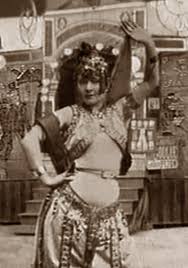Aniseteph
New member
:lol: Until you get to Lycra, elastic and fashion really doesn't work that way.
There were vamps before Theda Bara; earliest OED reference is 1911, which doesn't mean it wasn't around earlier. According to Wikipedia she made a film called "The Vamp" in 1914 but I doubt they would have titled a film that way unless people knew what it meant already. I think the Salome craze had already brought the vamp character to such prominence that early Hollywood was bound to jump on the bandwagon.
The earliest proto-bedlah I've seen (outside Orientalist art) is about 1895.

This is La Goulue, the Moulin-Rouge dancer Toulouse-Lautrec painted, outside the place she set up in 1895. I think it's faked from a studio shot and the street view, but it's her. Clearly it's a vest under a little bolero, but the two-piece vibe is already there (and coins!). If you wanted to make it naughtier you'd do it sans-vest or at least in a nekkid-look bodystocking. And less than 10 years later Mata Hari is doing exactly that, again in Paris, in a jewelled bra.
Yes these are "Western", but these images of what a ME dancing girl "should" look like are there way before Hollywood (and I still haven't seen any early Hollywood 2 piece-clad dancing girls).
:clap: If you take "traditional modern Egyptian cabaret bellydance" in the OP to mean American Egyptian cabaret bellydance then it's a bit less WTF. Yes, that is an American construct. But to say Egyptian/Turkish/Lebanese traditions and developments are as well... nope, still WTF?ing on that one.
There were vamps before Theda Bara; earliest OED reference is 1911, which doesn't mean it wasn't around earlier. According to Wikipedia she made a film called "The Vamp" in 1914 but I doubt they would have titled a film that way unless people knew what it meant already. I think the Salome craze had already brought the vamp character to such prominence that early Hollywood was bound to jump on the bandwagon.
The earliest proto-bedlah I've seen (outside Orientalist art) is about 1895.
This is La Goulue, the Moulin-Rouge dancer Toulouse-Lautrec painted, outside the place she set up in 1895. I think it's faked from a studio shot and the street view, but it's her. Clearly it's a vest under a little bolero, but the two-piece vibe is already there (and coins!). If you wanted to make it naughtier you'd do it sans-vest or at least in a nekkid-look bodystocking. And less than 10 years later Mata Hari is doing exactly that, again in Paris, in a jewelled bra.
Yes these are "Western", but these images of what a ME dancing girl "should" look like are there way before Hollywood (and I still haven't seen any early Hollywood 2 piece-clad dancing girls).
Tarik said:....Armenian, Greek, Turkish and Arabic music created a hybrid style, as well as a blending of Lebanese, Turkish and Greek styles with dashes of American creativity gave birth to American Belly Dance.
:clap: If you take "traditional modern Egyptian cabaret bellydance" in the OP to mean American Egyptian cabaret bellydance then it's a bit less WTF. Yes, that is an American construct. But to say Egyptian/Turkish/Lebanese traditions and developments are as well... nope, still WTF?ing on that one.
